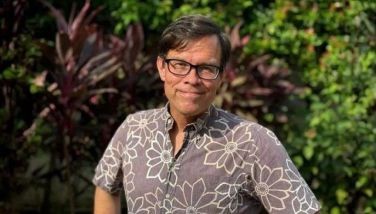Seeing Stars... And Planets
June 4, 2006 | 12:00am
Most Filipinos have never heard of Christopher Go, but the international media and no less than the National Aeronautics and Space Administration (NASA) of the United States certainly know of this amateur astronomer, since his discovery of Red Spot Jr., a crimson-like spot on the planet Jupiter.
Devoid of any portent of things to come, it was like any other day when Go scored this discovery. The tall and slender Chinese-Cebuano proceeded as usual with his favorite pastime–a nightly activity for him except when the skies are unclear– and peered into the Celestron C11 Schmidt Cassegrain telescope mounted at his home in Banilad, Cebu for any changing features of the planet Jupiter.
Go had been keeping an eye on Jupiter, along with Saturn and Mars, three of the brightest planets, for sometime now. In 2004, his first crack at planetary imaging yielded his first-ever discovery: a white spot in Jupiter’s North Equatorial Belt. He devoted a couple of weeks monitoring its progression, and not too long after, it grew into a major rift system. His images saw print in the magazine Sky and Telescope.
On February 27, 2006, he aimed his DMK21BF04 camera on the most outstanding mark of Jupiter, the Great Red Spot, and shot in monochrome, initially failing to see that lying in its periphery, particularly in its South Temperate Belt, was Red Spot Jr.
"I did not know what was going on. I was imaging the Great Red Spot. It was only when I processed the images the following day did I see that the spot turned red," Go, a furniture maker by day, animatedly tells STARweek during an interview in his office in Mactan Island.
He then perused the archives of the Association of Lunar and Planetary Observers (ALPO) over the Internet for comparison. In December 2005, it was recorded that the spot, from its whitish hue, had turned brown, and now, based on his photos, it had assumed the shade of the Great Red Spot. He alerted the ALPO-Jupiter Section of this sudden change.
Red Jr. is actually officially named "Oval BA." It first appeared in 2000 after three smaller spots, which reportedly surfaced in the 1930’s, collided and merged. Using the Hubble space telescope and ground-based telescopes, astronomers have for years tracked its developments with great detail, because a similar merger centuries ago could have possibly brought about the original Great Red Spot, a swirling storm twice as wide as the Earth and at least 300 years old.
And the reason Go’s discovery weighs in with more significance comes with the prospect that Red Jr. may persist to be a long-term feature in Jupiter’s atmosphere. It is presently half the size of the planet–and growing fast. Astronomers have also speculated on whether the remarkably reddish color would be permanent, but that should make the waiting more interesting. Go’s images are now being carried by all major astronomy sites on the World Wide Web.
Go might have sprung this surprise on his countrymen, but in the international astro-nomy community, he has already joined the ranks of the world’s planetary imaging masters. His works are cited in journals and Internet forums as very good. Curiously, his equipment and other devices are not even the best out there; and in fact, are dubbed as "modest." His secret to quality imaging? Cebu.
"First, Cebu is well-positioned because it’s close to the equator, and secondly, we have a stable atmosphere," he says. With planets passing overhead, coastal Cebu would spoil any astrophotographer, like a front row seat does to a spectator. There are some astronomers who employ telescopes 10 times more advanced and powerful than his, but they hardly match the breathtaking clarity of his images.
He feels even more privileged just thinking about how a recognized British astronomer and friend, Damien Peach, had to travel all the way to Barbados just for a high-quality shot, and he didn’t even have to leave his home.
If he’s flattered by all the attention, he’s not showing it. "This is the greatest discovery of my life and a once in a lifetime event," readily admits Go, a former college instructor, adding that he has no grand designs of surpassing this feat. He simply intends to continue staring at the skies as he has been doing for 20 years now–and to share this passion with others, particularly young people, through open-for-all activities.
Go started his affair with astronomy with an impulsive curiosity about Comet Halley on his way to senior year in high school in 1986. He still remembers how he had this hobby going via 10x40 binoculars and his parents’ Nikon MF2. Four years later, he got his first telescope as a gift.
While in college at the University of San Carlos in Cebu, this physics graduate formed a group of astronomy enthusiasts. The only time he slowed down was when he got married to his college sweetheart Vicky, he wrote on his website www.christone.net/astro. But not for long. "It’s just like any hobby," he explains. "If other guys are into collecting cars, I’m into telescopes."
A father of three–Steven Anthony, 6; Kathleen Nicole, 4; and Jane Frances, 2–Go jokes that this is the kind of hobby that doesn’t interfere with family life, as it keeps you at home at night.
It’s not even expensive, he stresses, because the total investment doesn’t even amount to a third of the cost of a car. "It’s a relaxing hobby and passion," the 30-something Go stresses.
This passion could never have enjoyed any of its recent rewards, were he made of lesser spunk and spirit. Because when he first posted his shots on the websites of US-based astronomical organizations, he was accused of plagiarizing shots from Hubble, which has been credited with many pioneering observations.
Furthermore, from the point of view of foreigners, it was impossible for someone outside the countries known to have made waves in this field–like the United States, United Kingdom, and Japan–to produce these kind of shots. Especially someone from a Third World country.
Nevertheless, determined to prove his credibility and the validity of his shots, Go produced a series of images, and since Hubble could only produce one shot in nine hours, he finally convinced the doubting Thomases that his images were originals.
Today, his exploits have resulted in some things he used to think unimaginable.
Last April 25, while in the US to attend a furniture fair, Go made a side trip to the Jet Propulsion Laboratory (JPL) in Pasadena, California, which not every astronomer–professional or otherwise–has been privileged to visit. Go, who is also a member of the Astronomical League of the Philippines, met up with JPL astronomer and research senior scientist Dr. Glenn Orton, one of the big names in astronomy he has connected with thanks to his "hobby".
"The meeting was fruitful," Go reports via email. "The meeting was basically about a joint venture on the July 2006 conjunction of the Great Red Spot and Red Jr. Other topics are possible joint ventures with future spacecrafts that will go to Jupiter, like Juno in 2008. Nothing final yet except for the July joint venture."
More importantly, he was tapped to be part of a research core group led by professional astronomers Dr. Imke de Pater and Dr. Phil Marcus of the University of California-Berkeley to work on a limited time and tight schedule of activities to image Red Jr. using Hubble and ground-based telescopes.
One such imaging session took place last April 25. He writes: "I am still processing the images, while the group is still digesting the data. The imaging session was a success."
In life, like the seemingly boundless sky, the possibilities of are limitless, and taking a cue from Go, to achieve success requires nothing less than one’s best shot.
To see his images, visit www.redspotjr.com
Devoid of any portent of things to come, it was like any other day when Go scored this discovery. The tall and slender Chinese-Cebuano proceeded as usual with his favorite pastime–a nightly activity for him except when the skies are unclear– and peered into the Celestron C11 Schmidt Cassegrain telescope mounted at his home in Banilad, Cebu for any changing features of the planet Jupiter.
Go had been keeping an eye on Jupiter, along with Saturn and Mars, three of the brightest planets, for sometime now. In 2004, his first crack at planetary imaging yielded his first-ever discovery: a white spot in Jupiter’s North Equatorial Belt. He devoted a couple of weeks monitoring its progression, and not too long after, it grew into a major rift system. His images saw print in the magazine Sky and Telescope.
On February 27, 2006, he aimed his DMK21BF04 camera on the most outstanding mark of Jupiter, the Great Red Spot, and shot in monochrome, initially failing to see that lying in its periphery, particularly in its South Temperate Belt, was Red Spot Jr.
"I did not know what was going on. I was imaging the Great Red Spot. It was only when I processed the images the following day did I see that the spot turned red," Go, a furniture maker by day, animatedly tells STARweek during an interview in his office in Mactan Island.
He then perused the archives of the Association of Lunar and Planetary Observers (ALPO) over the Internet for comparison. In December 2005, it was recorded that the spot, from its whitish hue, had turned brown, and now, based on his photos, it had assumed the shade of the Great Red Spot. He alerted the ALPO-Jupiter Section of this sudden change.
Red Jr. is actually officially named "Oval BA." It first appeared in 2000 after three smaller spots, which reportedly surfaced in the 1930’s, collided and merged. Using the Hubble space telescope and ground-based telescopes, astronomers have for years tracked its developments with great detail, because a similar merger centuries ago could have possibly brought about the original Great Red Spot, a swirling storm twice as wide as the Earth and at least 300 years old.
And the reason Go’s discovery weighs in with more significance comes with the prospect that Red Jr. may persist to be a long-term feature in Jupiter’s atmosphere. It is presently half the size of the planet–and growing fast. Astronomers have also speculated on whether the remarkably reddish color would be permanent, but that should make the waiting more interesting. Go’s images are now being carried by all major astronomy sites on the World Wide Web.
Go might have sprung this surprise on his countrymen, but in the international astro-nomy community, he has already joined the ranks of the world’s planetary imaging masters. His works are cited in journals and Internet forums as very good. Curiously, his equipment and other devices are not even the best out there; and in fact, are dubbed as "modest." His secret to quality imaging? Cebu.
"First, Cebu is well-positioned because it’s close to the equator, and secondly, we have a stable atmosphere," he says. With planets passing overhead, coastal Cebu would spoil any astrophotographer, like a front row seat does to a spectator. There are some astronomers who employ telescopes 10 times more advanced and powerful than his, but they hardly match the breathtaking clarity of his images.
He feels even more privileged just thinking about how a recognized British astronomer and friend, Damien Peach, had to travel all the way to Barbados just for a high-quality shot, and he didn’t even have to leave his home.
If he’s flattered by all the attention, he’s not showing it. "This is the greatest discovery of my life and a once in a lifetime event," readily admits Go, a former college instructor, adding that he has no grand designs of surpassing this feat. He simply intends to continue staring at the skies as he has been doing for 20 years now–and to share this passion with others, particularly young people, through open-for-all activities.
Go started his affair with astronomy with an impulsive curiosity about Comet Halley on his way to senior year in high school in 1986. He still remembers how he had this hobby going via 10x40 binoculars and his parents’ Nikon MF2. Four years later, he got his first telescope as a gift.
While in college at the University of San Carlos in Cebu, this physics graduate formed a group of astronomy enthusiasts. The only time he slowed down was when he got married to his college sweetheart Vicky, he wrote on his website www.christone.net/astro. But not for long. "It’s just like any hobby," he explains. "If other guys are into collecting cars, I’m into telescopes."
A father of three–Steven Anthony, 6; Kathleen Nicole, 4; and Jane Frances, 2–Go jokes that this is the kind of hobby that doesn’t interfere with family life, as it keeps you at home at night.
It’s not even expensive, he stresses, because the total investment doesn’t even amount to a third of the cost of a car. "It’s a relaxing hobby and passion," the 30-something Go stresses.
This passion could never have enjoyed any of its recent rewards, were he made of lesser spunk and spirit. Because when he first posted his shots on the websites of US-based astronomical organizations, he was accused of plagiarizing shots from Hubble, which has been credited with many pioneering observations.
Furthermore, from the point of view of foreigners, it was impossible for someone outside the countries known to have made waves in this field–like the United States, United Kingdom, and Japan–to produce these kind of shots. Especially someone from a Third World country.
Nevertheless, determined to prove his credibility and the validity of his shots, Go produced a series of images, and since Hubble could only produce one shot in nine hours, he finally convinced the doubting Thomases that his images were originals.
Today, his exploits have resulted in some things he used to think unimaginable.
Last April 25, while in the US to attend a furniture fair, Go made a side trip to the Jet Propulsion Laboratory (JPL) in Pasadena, California, which not every astronomer–professional or otherwise–has been privileged to visit. Go, who is also a member of the Astronomical League of the Philippines, met up with JPL astronomer and research senior scientist Dr. Glenn Orton, one of the big names in astronomy he has connected with thanks to his "hobby".
"The meeting was fruitful," Go reports via email. "The meeting was basically about a joint venture on the July 2006 conjunction of the Great Red Spot and Red Jr. Other topics are possible joint ventures with future spacecrafts that will go to Jupiter, like Juno in 2008. Nothing final yet except for the July joint venture."
More importantly, he was tapped to be part of a research core group led by professional astronomers Dr. Imke de Pater and Dr. Phil Marcus of the University of California-Berkeley to work on a limited time and tight schedule of activities to image Red Jr. using Hubble and ground-based telescopes.
One such imaging session took place last April 25. He writes: "I am still processing the images, while the group is still digesting the data. The imaging session was a success."
In life, like the seemingly boundless sky, the possibilities of are limitless, and taking a cue from Go, to achieve success requires nothing less than one’s best shot.
To see his images, visit www.redspotjr.com
BrandSpace Articles
<
>
- Latest
- Trending
Trending
Latest
Trending
Latest
Recommended



















